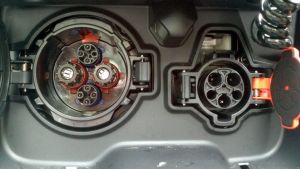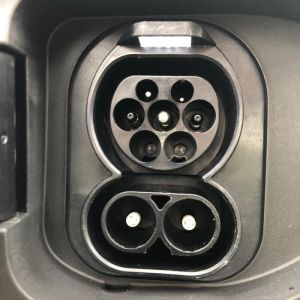Rapid Charging: Difference between revisions
(Initial Rapid charging page) |
(CCS pinout quick reference) |
||
| (8 intermediate revisions by 4 users not shown) | |||
| Line 1: | Line 1: | ||
There are 2 commonly used protocols for Rapid Charging an EV conversion. | There are 2 commonly used protocols for DC Rapid Charging an EV conversion. | ||
{| class="wikitable" | {| class="wikitable" | ||
|+ | |+ | ||
| | |||
=== Chademo === | |||
| | |||
=== [[CCS Fast Charging (Overview)|CCS]] === | |||
|- | |- | ||
| | | Chademo uses a separate socket to the ac charging port. This is found on Nissan Leaf.[[File:2016-03-18 10-58-08 97-1024x576.jpg|none|thumb]] | ||
The port on the left is the Chademo port on a Nissan Leaf. This is probably the cheapest standard to get DC rapid charging in your conversion. | |||
There are multiple options for a Chademo controller. | |||
* [https://evbmw.com/index.php/evbmw-webshop/vcu-boards/zombie-vcu The ZombieVerter VCU]supports [https://www.youtube.com/watch?v=zuPvgzQt6XQ&t=1018s Chademo] | |||
* [https://www.evcreate.nl/shop/charging/chademo-fast-charge-controller/ EVCreate] | |||
* [[Chademo With Arduino Due]] | |||
* [[Chademo with ESP32-Chademo]] | |||
| CCS combines the AC charging port with 2 additional pins for DC charging and comes in 2 different socket type, type 1 more common in USA and the type 2 more common in Europe.[[File:Ccs-socket.jpg|none|thumb]] | |||
The port above is a type 2 CCS socket, for AC charging the normal AC type 2 connector fits in to the top part and the bottom usually has an additional cover for the pins. | |||
You can find a generall overview of [[CCS Fast Charging (Overview)|CCS and Controller Options list here]]. | |||
One way of getting CCS working is with the [[BMW I3 Fast Charging LIM Module|BMW i3 LIM Module]] | |||
Another way may be using a TP-Link TL-PA4010 ("AV500") and [[CCS EVCC using AR7420|repurposing it as a CCS EVCC]]. | |||
A third method may be to a board that contains an STM microcontroller and a QCA700x IC<ref>https://openinverter.org/forum/viewtopic.php?t=2046&sid=2af4b18b1808b7e8b481eafa5f540357</ref>. | |||
====== Pinout ====== | |||
Quick reference of the CCS2 pinout. Looking at the car: | |||
<pre> | |||
PP CP | |||
L1 PE N | |||
L2 L3 | |||
DC- DC+ | |||
</pre> | |||
As a rule of thumb, CP is on the same side as DC+. PP is the pin that the car supplies about 4.5 V, and on that side is DC-. | |||
[[Category:Charger]] | |||
|} | |} | ||
<references /> | |||
Latest revision as of 07:11, 23 February 2024
There are 2 commonly used protocols for DC Rapid Charging an EV conversion.
Chademo |
CCS |
| Chademo uses a separate socket to the ac charging port. This is found on Nissan Leaf.
|
CCS combines the AC charging port with 2 additional pins for DC charging and comes in 2 different socket type, type 1 more common in USA and the type 2 more common in Europe.
You can find a generall overview of CCS and Controller Options list here.
Another way may be using a TP-Link TL-PA4010 ("AV500") and repurposing it as a CCS EVCC. A third method may be to a board that contains an STM microcontroller and a QCA700x IC[1]. PinoutQuick reference of the CCS2 pinout. Looking at the car: PP CP L1 PE N L2 L3 DC- DC+ As a rule of thumb, CP is on the same side as DC+. PP is the pin that the car supplies about 4.5 V, and on that side is DC-. |

